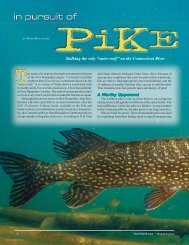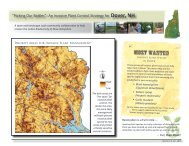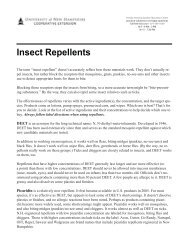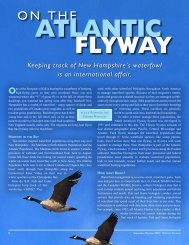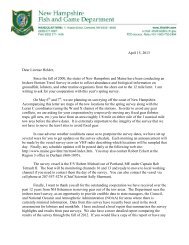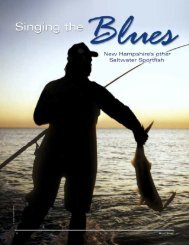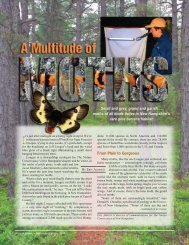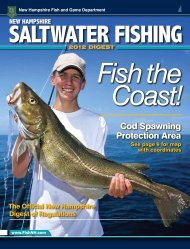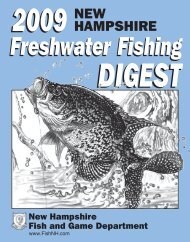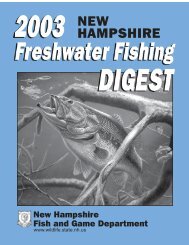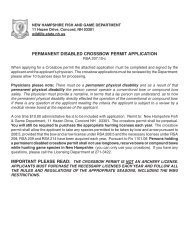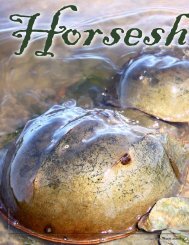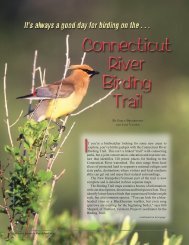Official NH Digest of Regulations - New Hampshire Fish and Game ...
Official NH Digest of Regulations - New Hampshire Fish and Game ...
Official NH Digest of Regulations - New Hampshire Fish and Game ...
You also want an ePaper? Increase the reach of your titles
YUMPU automatically turns print PDFs into web optimized ePapers that Google loves.
Lobster & Crab<br />
Gear Restrictions<br />
Lobster trap construction<br />
Lobsters shall only be taken by traps in state waters.<br />
Lobster Gear <strong>Regulations</strong>—Lobster Trap<br />
Volume No more than 22,950 cubic inches<br />
Escape Vent Size<br />
(in parlor section)<br />
Escape Panels<br />
(in parlor section)<br />
Runners or Sills<br />
Weak Links<br />
Groundlines<br />
Trap <strong>and</strong> Trap<br />
Tag Limits<br />
At least 1 15 /16 inches X 5¾ inches or two circular<br />
vents at least 2 7 /16 inches in diameter; see other<br />
options below<br />
• Hinged at the top <strong>of</strong> positively buoyant or bottom <strong>of</strong><br />
negatively buoyant panels<br />
• Tied with an untreated natural fiber not to exceed<br />
3<br />
/16 inches in diameter OR nonstainless, uncoated,<br />
ferrous metal wire not exceeding 3 /32 inches in<br />
diameter<br />
• Opening must be at least 3¾ inches by 3¾ inches<br />
when open or removed<br />
• See further details below<br />
Must have at least 2 running the length <strong>of</strong> the bottom<br />
<strong>of</strong> the trap<br />
600-pound breaking strength seaward <strong>of</strong> harbors<br />
(see Tide Table Pull-out Section–1)<br />
Sinking if seaward <strong>of</strong> the harbors (see Tide Table<br />
Pull-out Section–1)<br />
• Depending on license type: recreational (5 traps),<br />
or commercial (100, 600, or 1200 traps)<br />
• Season runs June 1 – May 31<br />
• <strong>New</strong> tags must be affixed by June 1<br />
Escape vents or gaps<br />
Must be in the parlor section <strong>of</strong> the trap <strong>and</strong> may be:<br />
1. A rectangular or oblong escape vent at least 1 15 /16 inches by<br />
5¾ inches, located next to the bottom edge;<br />
2. Two circular vents at least 2 7 /16 inches in diameter;<br />
3. A gap created by raising, modifying or separating the horizontal<br />
or vertical laths so that they create openings as described<br />
in 1) or 2) above;<br />
4. A gap caused by separating both ends <strong>of</strong> 2 laths 1¾ inches on<br />
the top <strong>of</strong> the parlor section next to the middle bow or supporting<br />
frame <strong>and</strong> directly over the parlor head; or<br />
5. Vents cut in the side or the end <strong>of</strong> a wire or plastic trap that<br />
comply with the dimensions in 1) <strong>and</strong> 2) above.<br />
Biodegradable escape panels <strong>and</strong> runners<br />
Each trap must have escape panels <strong>and</strong> at least two runners or sills<br />
extending the entire length <strong>of</strong> the trap. Nothing may be placed in<br />
the parlor section <strong>of</strong> the trap that will obstruct the opening after<br />
disintegration <strong>of</strong> the fiber. The traps must be constructed in the<br />
following manner:<br />
• Rectangular wire or plastic mesh traps:<br />
1. Every trap must have at least 2 parallel runners or sills<br />
attached to the bottom <strong>of</strong> the trap, running along the entire<br />
length <strong>of</strong> the exterior.<br />
2. Every trap must have an unobstructed escape panel which<br />
must be:<br />
• Located in the parlor section on the sides or end;<br />
• Hinged at the top <strong>of</strong> positively buoyant panels or at the<br />
bottom <strong>of</strong> negatively buoyant panels;<br />
• Tied with an untreated natural fiber such as cotton, sisal,<br />
hemp or jute not exceeding 3 /16 inches in diameter<br />
before immersion in sea water, or a piece <strong>of</strong> nonstainless,<br />
uncoated ferrous metal wire not exceeding 3 /32 inches in<br />
diameter; <strong>and</strong><br />
• Of sufficient size to create an opening <strong>of</strong> at least 3¾ inches<br />
x 3¾ inches when the panel is removed or opened.<br />
• Non-rectangular wire or plastic mesh traps:<br />
Must have at least two runners <strong>and</strong> an escape panel which will<br />
create an opening <strong>of</strong> 3¾ inches x 3¾ inches when open. These<br />
construction designs must be approved in writing by the <strong>Fish</strong><br />
<strong>and</strong> <strong>Game</strong> Director.<br />
• Wood lath traps—half round, round or rectangular:<br />
Every trap must have at least two runners <strong>and</strong> an escape panel.<br />
An escape panel can be created by one untreated, s<strong>of</strong>twood<br />
lath running the full length <strong>of</strong> the parlor section. The lath must<br />
have the same dimensions as the other laths on the trap. It<br />
must not be located where it will rest on the sea bottom. After<br />
disintegration, it must leave a space <strong>of</strong> at least 3¾ inches X 3¾<br />
inches between the adjacent laths. One can also be created by<br />
an opening <strong>of</strong> at least 3 inches between adjacent laths, running<br />
the length <strong>of</strong> the parlor section, which is laced with an untreated<br />
natural fiber such as cotton, sisal, hemp, or jute not exceeding<br />
3<br />
/16 inches in diameter before immersion in sea-water.<br />
Note: The <strong>Fish</strong> <strong>and</strong> <strong>Game</strong> Director may exempt specific trap<br />
designs from the escape vent <strong>and</strong> escape panel requirements if it<br />
can be conclusively proven that the specific trap design will only<br />
take crabs <strong>and</strong> is incapable <strong>of</strong> catching lobster. Approval will be<br />
granted in writing only after inspection.<br />
Gear Marking<br />
Each lobster or crab license holder has a color scheme or special<br />
markings indicated on their license. These must be used to mark<br />
all buoys. These colors must also be displayed on the boat, either<br />
by painting an area at least 1 square foot on the port <strong>and</strong> starboard<br />
side <strong>of</strong> the bow or by setting a painted buoy on the highest point <strong>of</strong><br />
the boat (excluding the mast) visible for 360 degrees. The buoy or<br />
colors must be permanently attached at all times while the lobster<br />
or crab gear is being fished.<br />
Gear Marking <strong>Regulations</strong><br />
All Fixed Gear<br />
Pot or Trap Trawls<br />
Lobster Buoy<br />
Lobster Trap<br />
Lobster Car<br />
Molesting <strong>of</strong> Lobster Pots<br />
• Permanently marked with the owner’s name<br />
• Flags <strong>and</strong> pennants affixed to buoys marking a<br />
string <strong>of</strong> gear must be <strong>of</strong> uniform color<br />
If 5 or more traps or pots, must be marked with<br />
buoys made <strong>of</strong> highly visible material set on both<br />
ends <strong>of</strong> the trawl<br />
Last name <strong>and</strong> initials, permanently marked (carved<br />
or br<strong>and</strong>ed); 2 buoys per 5 or more trap trawls<br />
Last name <strong>and</strong> initials, permanently marked<br />
(carved or br<strong>and</strong>ed)<br />
Last name <strong>and</strong> initials; permanently marked<br />
(carved or br<strong>and</strong>ed)<br />
Lobster pots, traps, warps (ropes), cars or buoys are private property,<br />
regardless <strong>of</strong> the location. This includes on the beach <strong>and</strong> in<br />
the rocks. No person except the owner or a conservation <strong>of</strong>ficer<br />
can possess, lift, molest or disturb them. To do so can result in a<br />
fine <strong>of</strong> $2,000 <strong>and</strong> up to 1 year in jail.<br />
Did You Know<br />
If you have a lobster license, you are required to report catch <strong>and</strong><br />
effort information. For more information, call Marine <strong>Fish</strong>eries<br />
Division at 603-868-1095.<br />
www.<strong>Fish</strong><strong>NH</strong>.com 27



